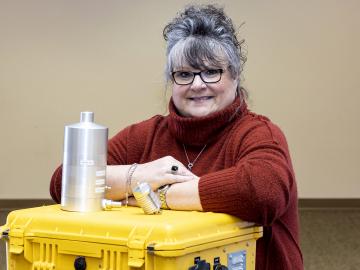
Filter News
Area of Research
- Advanced Manufacturing (6)
- Biology and Environment (19)
- Building Technologies (1)
- Clean Energy (43)
- Computational Engineering (1)
- Computer Science (3)
- Electricity and Smart Grid (1)
- Fusion and Fission (4)
- Isotopes (5)
- Materials for Computing (8)
- Mathematics (1)
- National Security (2)
- Neutron Science (5)
- Quantum information Science (1)
- Sensors and Controls (1)
- Supercomputing (4)
- Transportation Systems (1)
News Type
Date
News Topics
- 3-D Printing/Advanced Manufacturing (15)
- Advanced Reactors (1)
- Artificial Intelligence (2)
- Big Data (4)
- Bioenergy (7)
- Biology (11)
- Biomedical (2)
- Biotechnology (3)
- Buildings (7)
- Chemical Sciences (1)
- Clean Water (6)
- Climate Change (9)
- Composites (3)
- Computer Science (9)
- Coronavirus (4)
- Critical Materials (2)
- Cybersecurity (2)
- Decarbonization (3)
- Energy Storage (9)
- Environment (23)
- Exascale Computing (1)
- Fusion (3)
- Grid (7)
- High-Performance Computing (9)
- Isotopes (5)
- ITER (3)
- Materials (17)
- Materials Science (8)
- Mathematics (1)
- Mercury (1)
- Microscopy (3)
- Nanotechnology (2)
- National Security (2)
- Net Zero (1)
- Neutron Science (6)
- Nuclear Energy (1)
- Physics (1)
- Polymers (1)
- Quantum Computing (1)
- Quantum Science (4)
- Security (1)
- Space Exploration (3)
- Statistics (1)
- Sustainable Energy (26)
- Transportation (13)
Media Contacts

From Denmark to Japan, the UK, France, and Sweden, physicist Ken Andersen has worked at neutron sources around the world. With significant contributions to neutron scattering and the scientific community, he’s now serving in his most important role yet.

Rich Giannone uses bioanalytical mass spectrometry to examine proteins, the primary driver in biological systems.

If a nation tries to hide a clandestine nuclear operation, Paula Cable-Dunlap and her team will give their all to help find it. Just don’t call their work “nuclear CSI” – not where she can hear, at least.

Oak Ridge National Laboratory scientists proved molybdenum titanium carbide, a refractory metal alloy that can withstand extreme temperature environments, can also be crack free and dense when produced with electron beam powder bed fusion.

In a new twist to an existing award-winning ORNL technology, researchers have developed an electrocatalyst that enables water and carbon dioxide to be split and the atoms recombined to form higher weight hydrocarbons for gasoline, diesel and jet fuel.

A newly released dataset that tracks the movement of everything from food to gasoline across the United States by air, water, truck, rail and pipeline showed the value and tonnage of those goods rose significantly between 2012 and 2017.

A team of researchers at Oak Ridge National Laboratory and the University of Tennessee have developed a concrete mix that demonstrated high early strength within six hours of mixing, potentially doubling the production capacity for the precast industry.

Scientists at Oak Ridge National Laboratory have devised a method to identify the unique chemical makeup of every lithium-ion battery around the world, information that could accelerate recycling, recover critical materials and resolve a growing waste stream.

When Kashif Nawaz looks at a satellite map of the U.S., he sees millions of buildings that could hold a potential solution for the capture of carbon dioxide, a plentiful gas that can be harmful when excessive amounts are released into the atmosphere, raising the Earth’s temperature.

Nuclear physicist Caroline Nesaraja of the Department of Energy’s Oak Ridge National Laboratory evaluates nuclear data vital to applied and basic sciences.


